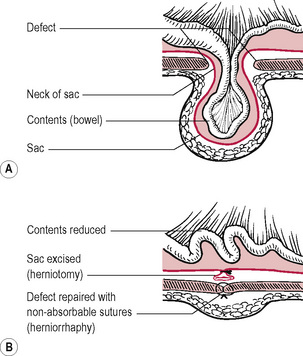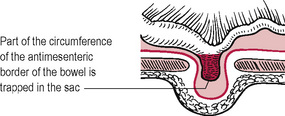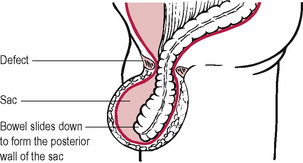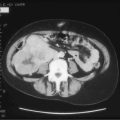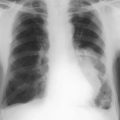CHAPTER 12 Abdominal wall and hernia
Herniae
Reducible hernia
This is one in which the contents of the sac reduce spontaneously or can be pushed back manually.
Classification of hernia
Types of hernia
Inguinal hernia
This is the most common form of hernia. There are two types: indirect and direct.
Direct
Both types may occur and straddle the inferior epigastric artery, the so-called ‘pantaloon’ hernia.
Treatment
Uncomplicated
2. Shouldice repair – this is a double-breasted repair of the transversalis fascia followed by suturing of the conjoint tendon to the inguinal ligament with non-absorbable sutures.
Obstructed and strangulated herniae
These require emergency surgery, with resection of bowel if necessary followed by surgical repair.
• Divide the superficial fascia (Camper’s and Scarpa’s) ligating the superficial veins (superficial epigastric vein and possibly the superficial circumflex iliac vein in the lateral end of the incision.
• Expose the aponeurotic fibres of external oblique. Open the external oblique aponeurosis in the line of its fibres, extending the incision into the superficial inguinal ring.
• Mobilize the cord. Check if there is a direct hernia (posterior to and separate from the cord). Carefully divide the layers of fascia covering the cord and check for an indirect sac. If indirect sac present, separate it carefully from the cord. Open the sac and reduce any contents. Twist the neck of the sac. Transfix and ligate the neck of the sac and excise redundant sac.
• Repair with Prolene mesh, attaching it to the pubic tubercle and inguinal ligament with a continuous Prolene suture and with interrupted sutures to the internal oblique and transversalis fascia, leaving an adequate opening for the cord to pass through.
Femoral hernia
Treatment
Repair of femoral hernia (low approach)
• Repair the femoral canal by suturing the inguinal ligament to the pectineal ligament without constricting the femoral vein.
Incisional hernia
This occurs through a defect in the scar of a previous abdominal incision.

